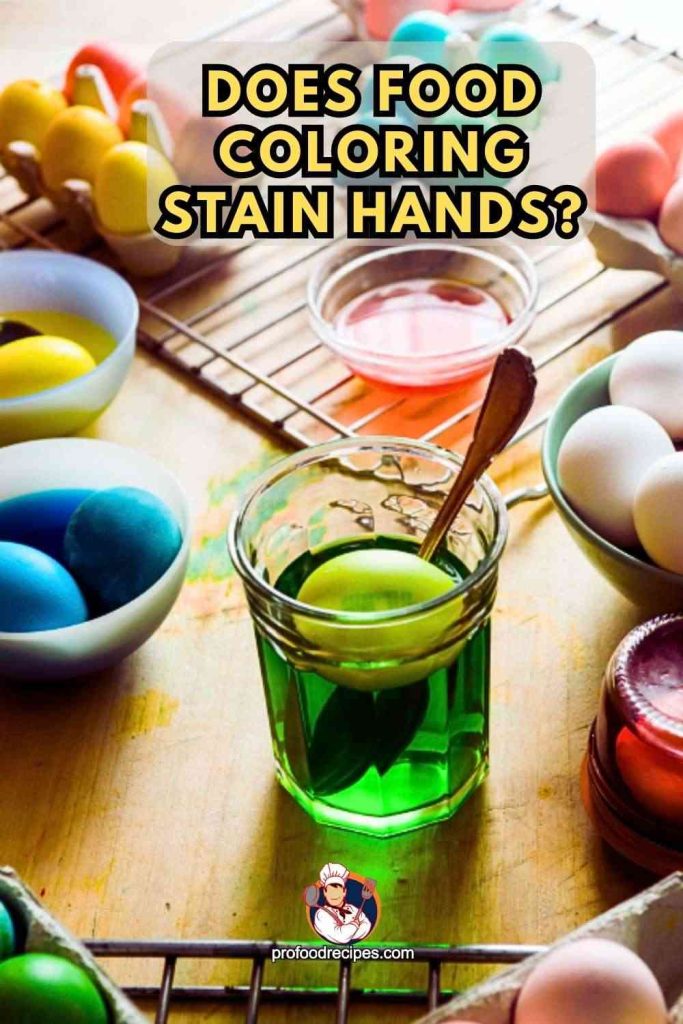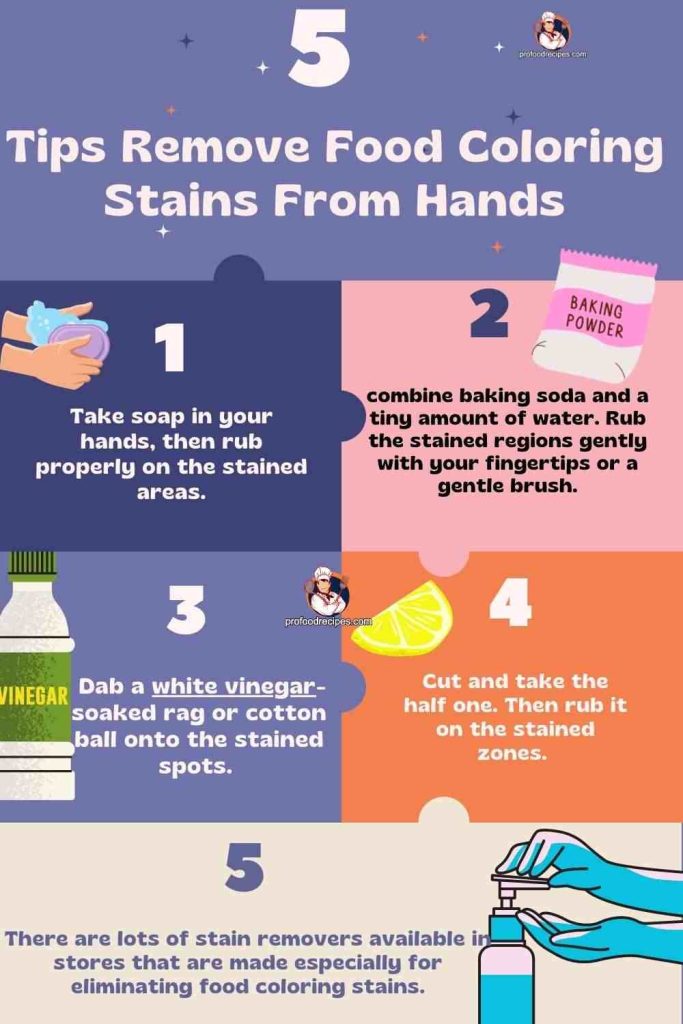Last Updated on August 10, 2023 by Amanda P. Brown
Yes, food coloring leaves stains on hands. But the positive news is that these stains are not lifelong. With some easy hand-washing tips, you can remove them. Even if you don’t take extra measures to clean color-stained hands, they will normally fade within 24 to 36 hours.
Food coloring has become an essential ingredient in modern cooking and baking. However, concerns have been raised regarding the safety and potential health risks.
While natural food colorings offer a safer alternative, it is essential to understand the benefits and drawbacks of using them in cooking.
This article will assist in exploring the detailed answer of ‘Does food coloring stain hands?’ pros/cons, stain removal tips, and informed culinary decisions on food coloring. Let’s uncover them.
Does Food Coloring Stain Hands?
Table of Contents

Food coloring is used in recipes to make your dishes more appealing and enhance presentation and consistency. However, when you do cooking/baking with food colors, it may leave a stain on your hands. This staining effect is more noticeable when using vibrant colors like red, blue, and green.
However, with some precautions, you can prevent these stains. Additionally, you can use tools like droppers or spoons to handle the coloring instead of touching it directly. Thus, it can reduce the likelihood of staining. If your hands accidentally catch the color stains, it is essential to clean them quickly.
While natural food colorings cause mild stains more than artificial ones, it is best to use them with caution. This technique will lessen the chances of stains. Thus, being mindful, you can enjoy the benefits of food coloring.
How Long Does Food Coloring Stain Hands?
Typically food color stains are not permanent. Usually, it fades away in 24 to 36 hours by doing the usual chores or frequent hand washing.
The time frame of this stain on hand may differ based on factors such as the kinds of food coloring applied (natural or artificial), the concentration of the color, and individual skin features.
When you use natural food coloring, their stains take a shorter time to fade away than synthetic colors. However, instant cleaning your hands reduce stains more quickly.
Is Food Coloring Safe on the Skin?
Yes, generally, they are safe on the skin. But still, you shouldn’t do it repeatedly. Otherwise, it may feel irritation on the skin. In some cases, if the food color is more concentrated, you can notice some allergic reactions on your skin. It especially happens if the color stain stays prolonged.
All these issues mainly happen due to synthetic colors. Natural ones are safer than it. Though decorating your food or face painting is recommended to get the fancy look, don’t put on these colors for longer, even if it is natural.
How to Remove Food Coloring Stains From Hands

Food coloring doesn’t offer a permanent stain on hands. But long time staining on hands can feel you hassled. Moreover, it increases the chances of getting allergic reactions and irritation also. So, it’s essential to remove these stains from your hands soon. In this regard, the below methods will assist you in doing it.
- The most popular method is to use soap and water. Take soap in your hands, then rub properly on the stained areas. Next, wash your hands thoroughly with clean, warm water.
- To create a paste, combine baking soda and a tiny amount of water. Rub the stained regions gently with your fingertips or a gentle brush. Then, rinse with water.
- Vinegar is one of the incredible ingredients to remove food coloring stains from hands. Dab a white vinegar-soaked rag or cotton ball onto the stained spots. Allow it to rest for a few mins before washing it with water.
- You can pick a lemon to go with one of the fastest methods. Cut and take the half one. Then rub it on the stained zones. The citric acid in lemons might aid in effectively dissolving the food coloring stains. Rinse your hands afterward.
- You can use commercial stain removers also. There are lots of stain removers available in stores that are made especially for eliminating food coloring stains. Before utilizing the product, observe the usage guidelines on the label.
Recommendations: To get rid of the stains fast, whatever method you pick, but do it as fast as possible. Otherwise, it will take more time and labor to take out.
Read More: How to Get Onion Smell Off Hands?
Are Food Coloring Good or Bad to Eat?
The impression of food coloring as excellent or poor is influenced by a variety of factors. Quality, type, and material – are the key factor in this decision. There are 2 types of food coloring. One is natural, and another is artificial/synthetic.
Natural food colorings are extracted from safe plant or mineral sources. These are quite health beneficial also. Moreover, they incredibly enhance the visual appeal of foods. Thus, its allure boosts your food craving and makes eating enjoyable.
On the contrary, some synthetic food colorings have raised concerns due to potential health like hyperactivity in children and allergies in some individuals.
Including the type, you also need to consider the quality of the food color. Try renowned or faithful brands, or go with homemade food colorings. Thus, you can ensure its safety more correctly.
However, if you take them moderately and within allowed limits, they are largely safe for you.
Read More: Can You Use Expired Bread Crumbs?
The Pros and Cons of Food Coloring
Food coloring assists in fulfilling a great demand in baking/cooking but also comes with some potential risks. Let’s learn them.
| Pros | Cons |
| They ensure an attractive and appealing appearance of food. | Synthetic food colorings may cause hyperactivity in children and allergies in sensitive individuals |
| They offer a stunning and artistic look to desserts and confectionaries. | Colorful foods can hide ingredient quality. Thus it can lead to unhealthy choices. |
| They aid in the preservation of color consistency in processed meals. | Overeating food coloring can lead to higher chemical intake and health implications. |
| Food coloring can compensate for natural color loss caused by processing or storage. Thus, you can get the desired appearance. | Certain food colorings’ production and disposal can harm the environment. |
FAQs
Is It Safe to Put Food Coloring on Your Lips?
Yes, it is safe to put food coloring on your lips. Especially those food colors made from food-grade or cosmetic labeled materials are safe. But removing these colors from lips may be so challenging and irritating.
Can You Put Food Coloring in Lotion?
Yes, you can use food color in lotion but with caution. Ensure safety, test for allergies, use a tiny amount and mix well. Be aware of potential consistency changes, shelf life impact, and the risk of staining. It would be best if you use cosmetic-grade colorants.
Is Blue Food Coloring Bad for You?
As per regulatory authorities, blue food coloring, like Brilliant Blue (E133), is generally considered safe in moderation. But excessive intake can lead you to many potential health risks. To ensure more safety, you can use natural sources of food colorings like spirulina or blueberries.
Is Red Food Coloring Harmful to Humans?
Yes, one of the most familiar food colors and the most used one. According to EFSA and FDA, “Allura Red” (E129) is generally considered safe for human consumption in moderation. But some studies convey allergies, migraine, and mental disorders in children.
Which Food Coloring is Safest?
Natural food colorings like annatto, turmeric, beetroot, spirulina, caramel, and chlorophyll are generally safer than artificial ones. FDA offers approval for nine synthetic colors to use in food. Among them most common are red 40, yellow 5 and 6.
What is the Most Unhealthy Food Dye?
Some Food dyes are healthy with caution and moderation. But some are unhealthy, such as red 3, blue 1, blue 2, citrus red 2, etc. The healthy ones also can turn into dangerous health risks if you take in excessive amounts, such as Red 40 (Allura Red), Yellow 5 (Tartrazine), and Yellow 6 (Sunset Yellow).
Final Verdict
From this article, you may now get the answer Does food coloring stain hands? Yes, it can leave stains, especially with vibrant colors. Though not typically permanent, you need to take precautions to prevent prolonged contact. In this regard, you might use the above-mentioned advice.
Natural food colorings offer safer alternatives than synthetics. Prompt stain removal methods, like soap, water, or vinegar, can minimize its impact. However, always use food coloring carefully, and consider moderation, the benefits and drawbacks of each type. Thus, you can enjoy the colorful world of food additives safely.
You May Also Like to Read:
- How to Store Enoki Mushrooms?
- How to Store Whoopie Pies?
- How to Wrap Mini Loaves for Gifts?
- How to Care for Wood Floors in Kitchen?
- What is the Effect of Oven Cleaners on Kitchen Countertops?

